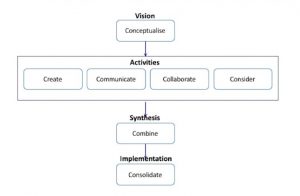What?
Below are summary notes of concepts and topics covered in each article. Following that is how it is important to the field of Educational Technology and me as a teacher and administrator in BC.
Friesen, N. (2009). Open Educational Resources: New Possibilities for Change and Sustainability. The International Review of Research in Open and Distributed Learning, 10(5). https://doi.org/10.19173/irrodl.v10i5.664
- results of an informal survey about collections of online educational resources (specifically longevity and attributes associated)
- some downfalls from old open educational resources in regards to lack of sustainability
- none prioritized open content through creative commons licensing
- not limited to specific subject area (too broad)
- started between 2001 and 2003
- lack of ongoing funding
- Therefore, these things need to be in place for a new platform to have more hope for long term usage
Conole, G., & Brown, M. (2018). Reflecting on the Impact of the Open Education Movement. Journal of Learning for Development – JL4D, 5(3). Retrieved from
http://jl4d.org/index.php/ejl4d/article/view/314
- Critiques the rise and impact of the Open Education movement (primarily in higher education) – in terms of impact on learning it focuses on three aspects: open educational resources, e-textbooks, and Massive Open Online Courses (MOOC’s) in regards to learning, teaching and research
- Describes three frameworks that help structure the implementation – 7 C’s of Learning Design, the SAMR model, and the ICAP framework
- Open Education definition: “resources, tools, and practices that employ a framework of open sharing to improve educational access and effectiveness worldwide” (Open Education Consortium, n.d.) *evolving term that covers a range of philosophies and practices aiming at widening access to learning
- Not a new concept, but new tools due to new digital technologies (especially social media)
- They aren’t all good – depends on how they are used
- Benefits of Open Education (from the OpenEdOz project, 2016)
- economies of scale through collaborative co-production of learning resources
- opportunities to raise the quality of learning at decreased time and financial cost
- enable provision of learning materials that are richer and more appropriate to the contexts and styles of learning of an increasingly diverse student community
- opportunities to provide learning to disadvantaged communities in remote and rural locations
- promote greater collaboration between universities in fostering peer review and collegial development of learning materials
- when used appropriately, they facilitate greater levels of transparency into the teaching process
- in order to effectively implement digital technologies to support open learning, teachers need to adopt new approaches to learning design (7 C’s, SAMR, ICAP)
- 7 C’s of Learning Design (see visual from article below)

- ICAP Framework (Interactive, Constructive, Active, and Passive) *defines cognitive engagement activities
- this hypothesis predicts that as students become more engaged with the learning materials, from passive to active to constructive to interactive, their learning will increase
- SAMR Model (Substitution, Augmentation, Modification, Redefinition)
- framework for designers to create optimal learning experiences
- learning activities that fall within the substitution and augmentation classifications are said to ENHANCE learning, while learning activities that fall within the modification and redefinition classifications are said to TRANSFORM learning
So what?
- SUSTAINABILITY – 6 of the sites listed in the resources are no longer available
- Online educational coursework is available through MIT, but you cannot get a degree unless you pay to be a part of the program (This is becoming more prevalent – eg. MOOC’s through UBC)
- Tracy had a great comment of Hypothesis – “Why limit myself to a collection when I can google what I need and source from there?”
- Use of site with collections of online material for teaching (TeachersPayTeachers) – there is so much out there already, there is no need to reinvent the wheel unless you have to
- How to make MOOC’s accessible to all yet differentiated for different types of learners (what does mass produced really mean?)
- E-Textboks allow learners to access their learning resources from anywhere
- E-texts also help to decrease students environmental impact (no need to print and reprint texts based on updated information)
- Makes learning accessible to a wider demographic
- lack of understanding in the post secondary world about how to recognize learning through OER and MOOC’s
Now what?
- Hard for some teachers to move away from textbooks and online (especially with the ‘new’ curriculum – not a lot of resources provided) *teachers have to work harder to collate and develop their resources *easy for them to move through the chapters (but this limits access and students understanding of concepts)
- How are we getting devices into the hands of less privileged demographics in order to level the playing field of access to education?
- Class discussion about the digital component of high school courses in Ontario
- good for students to start developing the skills and strategies to independently move through course content online
- is there a conversation about balance of digital vs. classroom teaching and learning (how much time are students spending online per day – inside and outside of the classroom?) *some of the teachers at my school right now are struggling with this issue*
Recent Comments